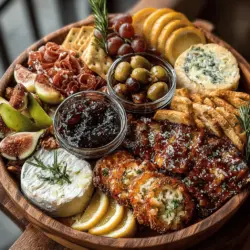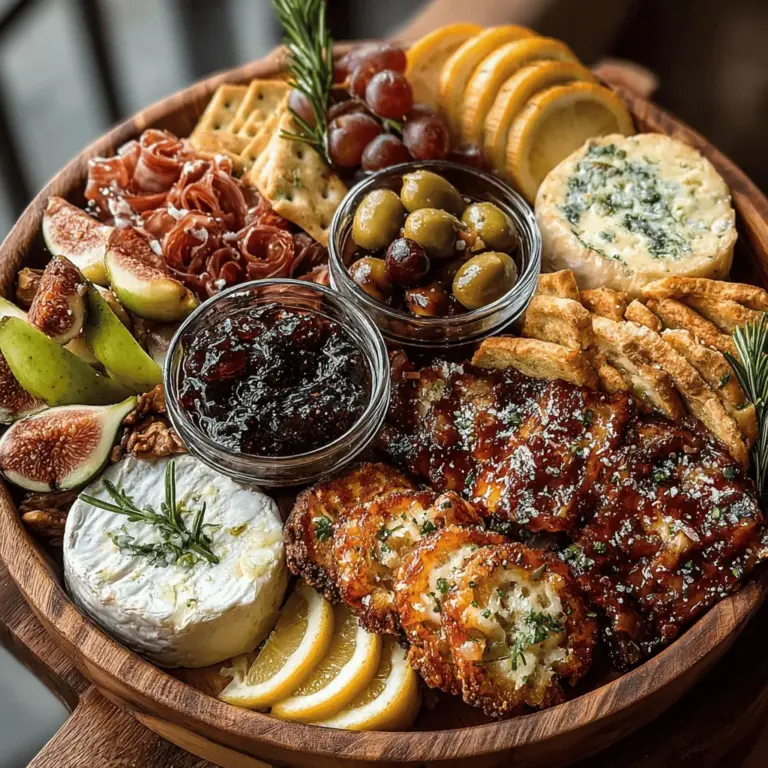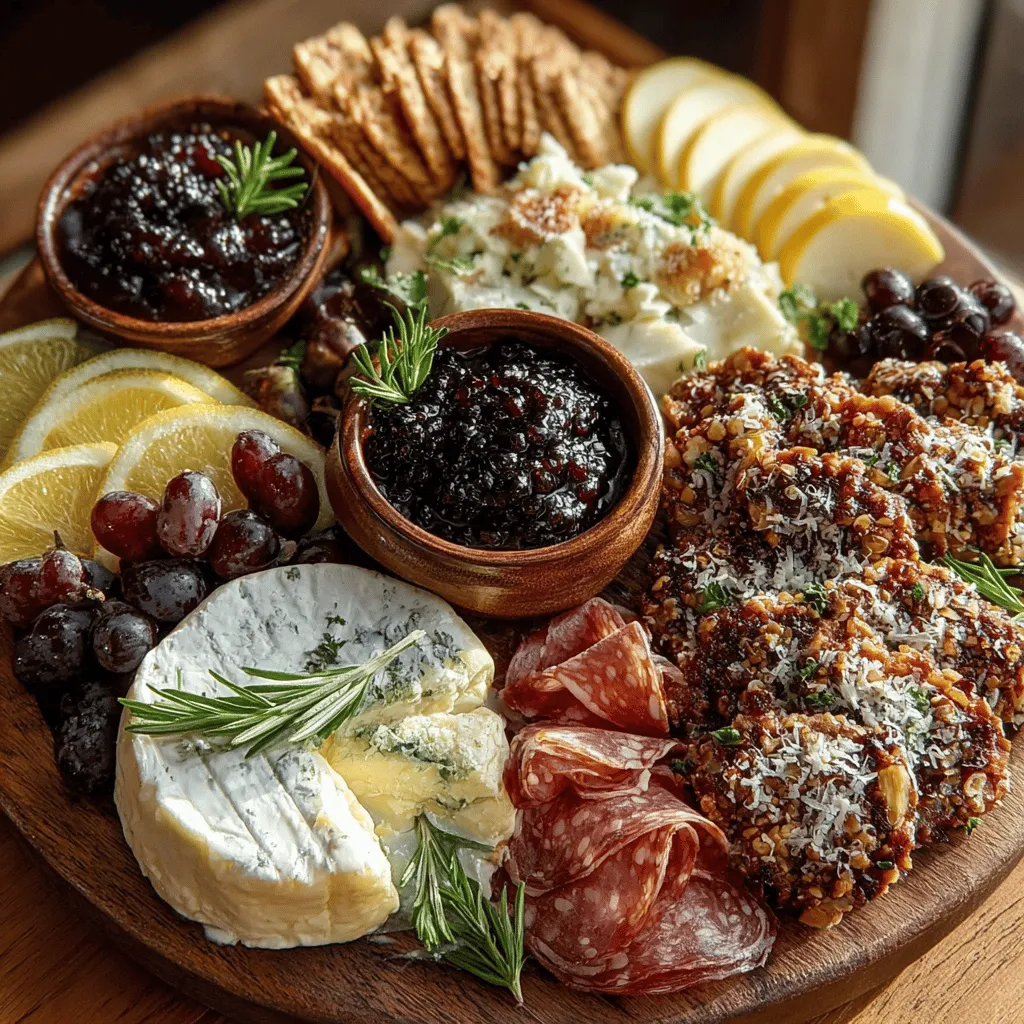Introduction
Creating the perfect charcuterie board is an art that combines flavors, textures, and visual appeal. A gooey charcuterie board, featuring a selection of decadent cheeses, savory meats, fresh fruits, and delightful accompaniments, is perfect for gatherings, celebrations, or a cozy night in. This guide will walk you through every step of assembling a mouthwatering gooey charcuterie board that will impress your guests and elevate your entertaining skills.
The charm of a charcuterie board lies not just in its variety but also in its ability to cater to diverse palates. Whether you are hosting a festive gathering, planning a romantic dinner, or simply indulging in a night of self-care, a gooey charcuterie board is an excellent way to showcase your culinary creativity. With careful consideration of each component, you can create a visually stunning and delicious spread that captures the essence of gourmet snacking.
Understanding the Components of a Charcuterie Board
Definition and Origin of Charcuterie Boards
Charcuterie, a French term that translates to “cooked meats,” originally referred to the art of preparing and presenting cured meats. The concept has evolved over time, expanding to include a wide variety of accompaniments such as cheeses, fruits, nuts, and spreads. Today, charcuterie boards are celebrated for their ability to blend flavors and textures into a cohesive experience, making them a popular choice for social gatherings and intimate dinners alike.
The roots of charcuterie can be traced back to France, where butchers would display their craft through a variety of cured meats, often paired with local cheeses and seasonal produce. This tradition has since spread globally, inspiring variations that reflect regional tastes and preferences. The modern charcuterie board pays homage to this rich history while allowing for personal flair and creativity in its presentation.
Importance of Variety in Ingredients
One of the key elements of a successful charcuterie board is variety. A well-rounded board will include a mix of flavors, colors, and textures that engage the senses and keep guests coming back for more. Incorporating a range of ingredients ensures that there is something for everyone, catering to different dietary preferences and flavor profiles.
When selecting ingredients for your gooey charcuterie board, aim for a balance of creamy, salty, sweet, and savory items. This will create a harmonious experience, allowing each component to shine while complementing the others. Additionally, consider the visual appeal of your board; a colorful assortment of ingredients arranged thoughtfully can elevate your presentation and entice guests to dig in.
How to Balance Flavors and Textures
Balancing flavors and textures is crucial when creating a charcuterie board. Aim for a mix of creamy, crunchy, spicy, and sweet elements to keep the palate engaged. For instance, pairing a rich, gooey Brie with the crunch of assorted nuts can create a delightful contrast. Similarly, the saltiness of cured meats can be balanced with the sweetness of fresh fruits or honey.
When planning your board, think about the progression of flavors. Start with milder cheeses and meats, progressing to bolder options, and finish with sweet or tangy accompaniments. This thoughtful arrangement will enhance the tasting experience, allowing guests to savor each bite fully.
Selecting the Right Cheeses
Overview of Cheese Types for Charcuterie Boards
Cheese is undoubtedly the star of any charcuterie board, and selecting the right varieties can make all the difference. A gooey charcuterie board typically features a mix of soft, creamy cheeses, sharp aged options, and unique flavors that can intrigue the palate.
When choosing cheeses, consider including a range of textures, from soft and spreadable to firm and crumbly. This variety will not only enhance the visual appeal of your board but also provide different tasting experiences for your guests.
Brie and Camembert: Creamy Delights
Brie and Camembert are two of the most beloved cheeses for charcuterie boards, thanks to their rich, creamy textures and mild flavors. Brie, with its luscious interior and soft, edible rind, offers a buttery taste that pairs beautifully with fruits and cured meats. Camembert, on the other hand, has a slightly stronger flavor, making it an excellent choice for those who prefer a bit more complexity.
When serving these cheeses, allow them to come to room temperature before presenting them on your board. This will enhance their flavor and make them even more enjoyable to spread on crackers or bread.
The Unique Flavor Profile of Goat Cheese
Goat cheese is a versatile option that adds a tangy and creamy element to your charcuterie board. Its distinct flavor profile contrasts nicely with the richness of Brie and the saltiness of cured meats. Additionally, goat cheese can come in various forms, from soft and spreadable to crumbly varieties, allowing for further texture diversity on your board.
Consider adding flavored goat cheeses, such as those infused with herbs, garlic, or spices, to elevate the tasting experience. These unique varieties can introduce exciting new flavors to your board, captivating your guests’ taste buds.
Tips for Serving Cheese at Room Temperature
To fully appreciate the flavors and textures of your chosen cheeses, it’s essential to serve them at room temperature. Cold cheese can mask its complexities, so aim to take your cheeses out of the refrigerator at least 30 minutes before serving. This will allow them to soften and develop their full flavor profile.
When arranging the cheeses on your board, consider their size and shape. Cut some into wedges or slices for easy serving, while leaving others whole for a rustic touch. Be sure to provide cheese knives or spreaders to make it easy for guests to serve themselves.
Choosing Quality Charcuterie Meats
The Role of Meats in a Charcuterie Board
Cured meats play a vital role in the overall experience of a charcuterie board. Their rich, savory flavors complement the cheeses and other accompaniments, creating a well-rounded taste sensation. Including a variety of meats not only enhances the flavor profile of your board but also adds an element of heartiness that can satisfy even the most discerning appetites.
When selecting meats, aim for high-quality, artisanal options that showcase different textures and flavors. This will ensure that your board is not only delicious but also a feast for the eyes.
Prosciutto: The Salty Sweetness
Prosciutto is a staple on charcuterie boards, known for its delicate, salty-sweet flavor and melt-in-your-mouth texture. This Italian dry-cured ham is typically sliced paper-thin, making it easy to pair with cheeses and fruits. Its richness complements the creaminess of soft cheeses like Brie, while also providing a delightful contrast to the sweetness of figs or grapes.
When adding prosciutto to your board, consider folding the slices into loose rosettes or rolling them for an elegant presentation. This will not only enhance the visual appeal of your board but also make it easy for guests to serve themselves.
Salami: A Classic Choice
Salami is another classic choice for charcuterie boards, offering a robust flavor that contrasts beautifully with milder cheeses. With various types available, such as Genoa, pepperoni, and soppressata, you can introduce different flavor profiles to your board. Salami’s slightly spicy and savory notes make it a versatile option that pairs well with a range of accompaniments.
To add visual interest, consider arranging the salami in overlapping circles or folding the slices in half to create height and texture on your board. This not only enhances the presentation but also encourages guests to explore the different flavors.
Chorizo: Adding a Spicy Kick
For those who enjoy a bit of heat, chorizo is an excellent addition to a gooey charcuterie board. This Spanish cured sausage is known for its bold flavors, often infused with paprika and garlic, which can add an exciting kick to your spread. The spiciness of chorizo pairs wonderfully with creamy cheeses and sweet fruits, creating a balanced tasting experience.
When including chorizo, consider slicing it into thick rounds or serving it in a spiral shape to showcase its vibrant color. This will not only enhance the visual appeal of your board but also make it easy for guests to help themselves.
How to Arrange Meats for Maximum Visual Appeal
Arranging the meats on your charcuterie board can significantly impact its overall presentation. To create an inviting and visually appealing display, consider grouping similar meats together while also mixing in different shapes and sizes. This will help create a dynamic look that encourages guests to explore the various flavors.
Using small wooden boards or slate tiles can also enhance the rustic charm of your charcuterie board. When arranging the meats, be mindful of the flow and balance, ensuring that each component has its space while still feeling cohesive. This thoughtful arrangement will make your gooey charcuterie board not only delicious but also a stunning centerpiece for any gathering.
Creating a gooey charcuterie board is a delightful way to bring friends and family together over an array of flavors and textures. In this section, we will dive deeper into the essential elements that complete your charcuterie experience, from fresh fruits to delectable spreads and the perfect selection of breads and crackers. Let’s elevate your board with these thoughtful touches.
Grapes: A Refreshing Touch
Grapes are an essential addition to any charcuterie board, bringing a burst of freshness that balances the rich and savory flavors of cheeses and meats. When selecting grapes, opt for a mix of red and green varieties for visual appeal and contrasting flavors. Red grapes tend to be sweeter, while green grapes offer a refreshing tartness.
Tips for Using Grapes:
– Wash and dry: Ensure that your grapes are clean and dry before adding them to your board. This not only enhances their taste but also keeps your presentation neat.
– Cluster them: Instead of scattering grapes around the board, keep them in small bunches. This makes it easier for guests to grab a few at a time and adds to the visual charm of your presentation.
Figs: Sweet and Earthy Options
Figs add a touch of elegance and a unique flavor profile to your charcuterie board. Their sweet and earthy notes pair beautifully with creamy cheeses and savory cured meats. Fresh figs are delightful when in season, but dried figs are a fantastic alternative and are available year-round.
How to Incorporate Figs:
– Fresh Figs: Slice them in half to showcase their beautiful interiors and place them strategically alongside your cheese.
– Dried Figs: Arrange them in small clusters near sharper cheeses for a delightful contrast in flavor.
Apples: Crispness That Complements the Board
Crisp apples provide the perfect crunch and a refreshing taste that enhances the overall experience of your charcuterie board. Choose a variety like Honeycrisp or Granny Smith for their sweetness and tartness.
Apple Preparation Tips:
– Slicing: Cut apples into wedges or thin slices. To prevent browning, toss them lightly in lemon juice before placing them on the board.
– Pairing: Arrange the apple slices next to rich cheeses like Brie or sharp cheddar, where their crispness complements the creaminess.
Presentation Tips for Fruits
To ensure your fruits look inviting and vibrant, consider these presentation techniques:
– Color Coordination: Use a mix of colors and shapes to create a visually appealing arrangement. Group fruits of similar colors together for a striking display.
– Height Variation: Place fruits at different heights using small bowls or tiered stands. This adds dimension to your board and makes it more engaging for guests.
—
Enhancing the Board with Spreads
The Role of Spreads in Flavor Pairing
Spreads are integral to a charcuterie board as they not only enhance flavors but also encourage guests to experiment with different combinations. They add a creamy texture and a variety of tastes, from sweet to savory.
Honey: Sweetness that Complements Cheese
Honey is a classic addition that pairs beautifully with cheese. The sweetness of honey contrasts wonderfully with the saltiness of aged cheeses like Gouda or blue cheese. Consider using a small honey dipper for a touch of elegance.
Fig Jam: A Perfect Match for Savory Meats
Fig jam is another fantastic spread that complements both cheeses and meats. Its sweetness and earthy notes harmonize beautifully with prosciutto or salami. Serve it in a small ramekin to make it easy for guests to access.
Whole Grain Mustard: A Tangy Addition
Whole grain mustard adds a delightful tang that can cut through the richness of fatty meats. It pairs exceptionally well with cured meats like salami and can be served in a small bowl or directly on the board.
Creative Ways to Serve Spreads
– Small Jars: Use small mason jars or bowls for each spread, labeling them for easy identification.
– Spreader Knives: Provide a knife for each spread to prevent flavors from mixing and to maintain cleanliness on the board.
—
Choosing the Right Breads and Crackers
The Essential Role of Breads in a Charcuterie Board
Breads and crackers are crucial as they serve as the base for many cheese and meat pairings. The right selection can enhance the overall experience and provide additional textures to your board.
Selecting Crackers: Texture and Flavor Considerations
When choosing crackers, aim for a variety of textures and flavors. Include options like:
– Plain Crackers: A neutral base that allows the flavors of cheese and spreads to shine.
– Herbed Crackers: These add an extra layer of flavor and complexity to the board.
The Versatility of Baguette Slices and Breadsticks
Baguette slices are a must-have for any charcuterie board. They are sturdy enough to hold toppings without getting soggy and offer a delightful crunch. Breadsticks are also a fantastic addition, providing a light, crispy texture that pairs well with dips and spreads.
How to Arrange Breads for Easy Access
– Varied Heights: Use small stands or arrange them at different angles to create visual interest.
– Separate Areas: Designate a specific area for breads and crackers, keeping them distinct from the meats and cheeses to avoid flavor contamination.
—
Assembling Your Gooey Charcuterie Board
Preparing Your Board: Size and Material Considerations
When it comes to choosing a board, opt for wooden or slate boards for a rustic look. Ensure that your board is large enough to accommodate all components without overcrowding. A board measuring at least 24 inches by 18 inches is ideal for larger gatherings.
Step-by-Step Assembly Instructions
1. Start with the Base: Begin by placing your cheeses on the board first. Use space to create a balanced look, alternating between soft and hard cheeses.
2. Add Meats: Arrange your cured meats next to the cheeses. Fold them neatly or create small rolls for a visually appealing presentation.
3. Incorporate Fruits: Fill in gaps with clusters of grapes, slices of apples, and figs. This not only adds color but also fills the board.
4. Include Spreads: Place your spreads in small bowls or directly on the board, ensuring they are easily accessible.
5. Finish with Breads and Crackers: Lay out your breads and crackers at the edge of the board for easy access, ensuring they are clearly separated from the other components.
Tips for Creating Visual Appeal
– Color Balance: Distribute colors evenly across the board to maintain visual interest.
– Layering: Layer elements slightly on top of each other, creating depth and inviting guests to explore.
– Garnish with Herbs: Fresh herbs, such as rosemary or thyme, can be scattered around the board for added aroma and color.
—
Serving and Enjoying Your Charcuterie Board
Best Practices for Serving
Serve your charcuterie board at room temperature to allow the flavors to shine. Consider placing the board on a large table or counter where guests can gather around. Provide sufficient utensils, such as small forks and cheese knives, to facilitate easy serving.
Encouraging Guests to Create Their Own Combinations
Invite your guests to mix and match flavors. Encourage them to try pairing different cheeses with various meats or spreads to discover their favorite combinations. This interactive element adds fun to the experience.
Pairing Suggestions: Wines and Beverages
To elevate your charcuterie board even further, consider pairing it with complementary wines. A robust red wine, like Cabernet Sauvignon, pairs well with aged cheeses and cured meats, while a crisp white wine, such as Sauvignon Blanc, enhances the freshness of fruits.
—
Conclusion
A gooey charcuterie board is not just a feast for the palate but also a feast for the eyes. By carefully selecting and arranging each component, you can create a stunning display that will delight your guests. With this guide, you are now equipped to craft a charcuterie board that showcases your culinary creativity and impresses everyone at the table. Enjoy the process of assembling and sharing this delightful experience with friends and family, and let the flavors mingle and inspire joy in every bite.


